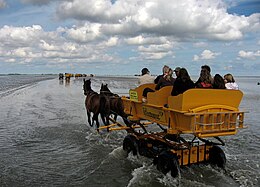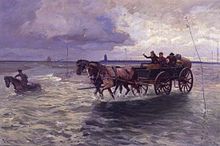Watt wagon


A Wattwagen is a carriage drawn by two workhorses that can navigate the seabed at low tide . Watt wagons operate between the Cuxhaven bathing suburbs of Duhnen and Sahlenburg and the island of Neuwerk in the Wadden Sea of the North Sea .
Construction
A watt wagon is built higher than other carriage wagons. This is necessary because a watt up 1.3 m deep creeks to ford needs. This is why the box attachment is at this height, while the seats of the upholstered benches are at a height of 1.75 m. If the water depth is greater, it is no longer possible to drive through tidal creeks, because then the workhorses no longer have any ground under their hooves.
The bases of the Watt wagons are made of oak . The original iron-tired wooden wheels were from the mid-20th century through with rubber tyred metal disc wheels replaced.
A leaning ladder carried on the Watt car is used to get the passengers on and off .
Track
The road from the mainland to the island of Neuwerk, twelve kilometers away, and back leads through both Lower Saxony and Hamburg . It is redefined every spring after a route survey by a joint commission under the direction of the authorities responsible in both federal states and marked with a prick .
Travel times
The possible travel time windows of the Watt wagons, which are shifted by approx. 50 minutes every day due to the changing tides , are calculated by the Federal Maritime and Hydrographic Agency for a year in advance (tide calendar) and are then available in printed form as a timetable .
Driving license
The mud flats are relatively shallow, but there can be depressions. Recognizing and assessing these while driving is the task of the watt wagon driver. You therefore need a special driver's license .
Watt car acceptance
Every spring, the Watt wagons are approved on the basis of the Hamburg and Lower Saxony Watt wagon regulations. The examination commission, which is responsible for Lower Saxony and Hamburg, includes a master wheelwright who, together with a master blacksmith , checks the watt wagons for stability, functionality and safety. A master saddler examines the harness and a veterinarian examines the horses for their health and fitness . The police also check the Wattwagen because they also participate in road traffic . The public order office checks the availability of first aid and rescue equipment, which also includes a radio . In addition, there must be a license for each Watt car as well as proof of liability insurance . The test report is created in writing. After a defect-free acceptance of the Watt wagon, the checked vehicles receive an inspection sticker for one year, which must be attached visibly.
See also
Web links
Individual evidence
- ↑ Printed matter 18/7478 of the Hamburg Citizenship : Application " Ensure long-term traffic with horse-drawn wagons between the island of Neuwerk (district of Hamburg-Mitte) and Cuxhaven-Sahlenburg (state of Lower Saxony)" by MP Alexander-Martin Sardina from November 28, 2007. Unanimously in the Plenary session of the parliament decided on December 13, 2007 (see plenary minutes 18/96, p. 5142A).
- ↑ Example: [https% 3A% 2F% 2Fwww.cuxhaven.de% 2Fpics% 2Fdownload% 2F1_1263453510% 2FWattwagenverordnung_vom_19.05.2016.pdf Wattwagenverordnung für Cuxhaven] (PDF)
- ↑ Printed matter 18/2897 of the Hamburg citizenship (PDF): Inquiry “Hamburgische Wattwagenverordnung” of the MP Till Steffen from 23 September 2005 and answer of the Senate .
- ↑ Watt wagon ordinance for Cuxhaven in the version of December 18, 2001 (PDF). Retrieved December 20, 2015.
- ↑ "There is no law in the Watt". Article in the Hamburger Abendblatt on the need for a Hamburg Watt wagon regulation . Retrieved December 20, 2015.
